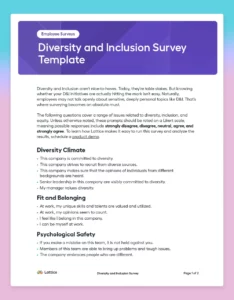In today’s globalized world, diversity and inclusion (D&I) are essential for businesses to succeed. A diverse workforce brings together a variety of perspectives, experiences, and skills, which can lead to increased creativity, innovation, and productivity. It can also help businesses better understand and serve their customers. An inclusive workplace is one where all employees feel respected, valued, and have the opportunity to reach their full potential.
A diversity and inclusion policy template can help you create a more diverse and inclusive workplace. This template provides a framework for developing policies and procedures that promote equal opportunity and fair treatment for all employees. It also includes best practices for creating an inclusive workplace culture.
Benefits of a Diversity and Inclusion Policy
Increased creativity and innovation
When employees from different backgrounds and perspectives come together, they can generate new ideas and solutions that would not have been possible if everyone were the same. This can lead to increased creativity and innovation, which can benefit the entire business.
Improved employee engagement and retention
Employees who feel respected, valued, and have the opportunity to reach their full potential are more likely to be engaged and motivated. This can lead to improved employee retention and a more productive workforce.
Better decision-making
When leaders have access to a diverse range of perspectives, they are more likely to make better decisions. This is because they are able to consider a wider range of factors and perspectives before making a decision.
Enhanced reputation
Businesses that are seen as being diverse and inclusive are more likely to attract top talent and customers. This can lead to a stronger brand reputation and increased profitability.
Steps to Create a Diversity and Inclusion Policy
1. Define the Purpose and Goals
The first step in creating a diversity and inclusion policy template is to define the purpose and goals of the policy. What do you hope to achieve by implementing this policy? Do you want to increase the representation of women and minorities in your workforce? Do you want to create a more inclusive workplace culture? Once you have defined your purpose and goals, you can start to develop specific policies and procedures that will help you achieve them.
2. Conduct an Assessment of the Current State
The next step is to conduct an assessment of the current state of diversity and inclusion in your workplace. This can be done through surveys, focus groups, and interviews with employees. The assessment should help you identify areas where you need to make improvements.
3. Develop Policies and Procedures
Once you have conducted an assessment of the current state, you can start to develop policies and procedures that will help you achieve your diversity and inclusion goals. These policies and procedures should address issues such as equal opportunity employment, fair treatment, and creating an inclusive workplace culture.
4. Communicate the Policy to Employees
Once you have developed your diversity and inclusion policy, it is important to communicate it to employees. This can be done through a variety of channels, such as email, company intranet, and training sessions. It is also important to make sure that employees understand the policy and how it applies to them.
5. Monitor and Evaluate the Policy
Once you have implemented your diversity and inclusion policy, it is important to monitor and evaluate it on a regular basis. This will help you ensure that the policy is effective and that it is achieving your desired results. You may need to make adjustments to the policy over time as needed.
Conclusion
A diversity and inclusion policy template can help you create a more diverse and inclusive workplace. By following the steps outlined in this article, you can develop a policy that will help you attract and retain top talent, improve employee engagement and productivity, and enhance your reputation. A diverse and inclusive workplace is good for business. It can help you attract and retain top talent, improve employee engagement and productivity, and enhance your reputation.
Creating a diverse and inclusive workplace is an ongoing process. It takes time, effort, and commitment. But it is worth it. A diverse and inclusive workplace is a better place to work for everyone.
FAQs
What is a diversity and inclusion policy template?
A diversity and inclusion policy template is a framework for developing policies and procedures that promote equal opportunity and fair treatment for all employees. It also includes best practices for creating an inclusive workplace culture.
Why is a diversity and inclusion policy important?
A diversity and inclusion policy is important because it helps to create a more diverse and inclusive workplace. This can lead to increased creativity, innovation, productivity, and employee engagement. It can also help businesses better understand and serve their customers.
What are some common elements of a diversity and inclusion policy?
Common elements of a diversity and inclusion policy include:
– A statement of purpose and goals
– A definition of diversity and inclusion
– Policies and procedures for equal opportunity employment and fair treatment
– Best practices for creating an inclusive workplace culture
– A process for monitoring and evaluating the policy
